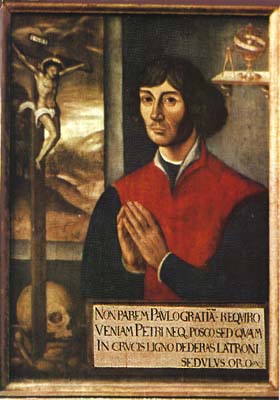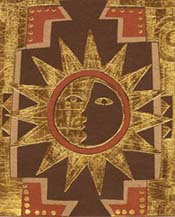



Connections Through Time, Issue 8: July - September 2000
![]()
 |
One more quote from Copernicus illustrates that within any given paradigm, science and society can only see and integrate a limited number of new "facts".
Finally we shall place the Sun himself at the center of the Universe.
All this is suggested by the systematic procession of events and the
harmony of the whole Universe, if only we face the facts,
as they say, `with both eyes open'.
Thomas Kuhn popularized the word 'paradigm' in his now-famous book, The Structure of Scientific Revolutions. Paradigms are essential to scientific growth. Kuhn described a paradigm as a collection of beliefs shared by scientists. These beliefs included a set of agreements, models, mathematics, and/or theories about how problems are to be understood and resolved. The mathematical theories are used to measure success and note "anomalies" to guide improvements to the theory. However, some anomalies may lead to a "crisis" in the paradigm.
Kuhn argued that science is not a steady, cumulative acquisition of knowledge. Instead, science is "a series of peaceful interludes punctuated by intellectually violent revolutions," which he described as "the tradition-shattering complements to the tradition-bound activity of normal science." After such revolutions, "one conceptual world view is replaced by another." These are the major paradigm shifts that often alter societal views of the universe in dramatic ways. For example, after the Copernicus world view took hold, the Earth was no longer viewed as being stationary at the center of the universe.
The key issues of the next major paradigm change, in our opinion, are subtler than the fact that the Earth is in motion. However, the change in world view may go just as deep into our belief systems. For example, the most fundamental belief in our current paradigm is that space-time-energy/mass are the most basic building blocks of our universe and of ourselves. It is easy to believe that, except for some minor details and more research-time, the current scientific paradigm will explain everything, certainly everything that is important. Isn't the universe adequately modeled by the theories of relativity and quantum mechanics?
And yet, the fundamental belief about space-time-energy being the basic construction of our universe may have to yield to an even more fundamental reality.
 To oversimplify, there is more to the universe than the physical universe we can measure. We may have to come to grips with the reality of our being imbedded in a universe of 10 or more dimensions. Or even more difficult, we may have to grasp the idea that we are fundamentally spiritual beings basically composed of light energy. What does this really mean and how will this eventually change our world view...no one knows, but some scientists are seriously looking at these theories because they know that something significant is missing in our current paradigm.
To oversimplify, there is more to the universe than the physical universe we can measure. We may have to come to grips with the reality of our being imbedded in a universe of 10 or more dimensions. Or even more difficult, we may have to grasp the idea that we are fundamentally spiritual beings basically composed of light energy. What does this really mean and how will this eventually change our world view...no one knows, but some scientists are seriously looking at these theories because they know that something significant is missing in our current paradigm.
Another illustration showing that a paradigm shift may be closer than many think is the current major scientific findings on the human genome (the full DNA sequence of the physical human body). These brilliant discoveries actually show our limitations as well as our strengths.
Here is a quote from a New Scientist news article:
IT TOOK more than a decade of effort, but Monday 26 June 2000 will be remembered as the day when humankind learned, in a sense, what it is to be human. Heads of government and Nobel laureates came together to hail the arrival of a "working draft" of the human genome: the set of genetic instructions which governs the assembly and function of all human beings.
The genetic instructions govern the chemistry of the body, but not the essential spirit within life...within each human being. In our opinion, the primary limitation of the current scientific paradigm is the lack of an approach for "comprehending" or "getting" what it is to be human. Consciousness is another essential part of being human. Science does not have a methodology, a set of rules, or any approach for studying spirit or consciousness. Science acknowledges the existence of consciousness, but only a few scientists will even go so far as to link spirit with the mysteries of light. The fundamental limitations of the current paradigm to even examine these issues may be one sign for the need of another paradigm shift.
Spirit and consciousness are intimately connected in mysterious ways. Perhaps individual consciousness is a partial separation from the Oneness or Wholeness associated with the deepest spiritual traditions of all faiths. Intuition seems to connect individual consciousness with the full spiritual wholeness of the universe. We recognize that the words, "spirit", "consciousness" and "intuition" as used here are not well-defined...that is exactly the point! These may well be the essential concepts that need to be added to the concepts of space-time-energy to achieve an expanded world view, a new paradigm, that fits and organizes the facts as we now know them.
The theory of the Implicate Order contains an ultraholistic cosmic view; it connects everything with everything else. In principle, any individual element could reveal "detailed information about every other element in the universe. "The central underlying theme of Bohm's theory is the "unbroken wholeness of the totality of existence as an undivided flowing movement without borders."
"The actual order (the Implicate Order) itself has been recorded in the complex movement of electromagnetic fields, in the form of light waves. Such movement of light waves is present everywhere and in principle enfolds the entire universe of space and time in each region..."
 The transition to such a paradigm is a noble challenge for science and society. Many scientists have intuitively sensed these deep connections, including the famous physicist, David Bohm Here are some quotes from an article about his view of physics and the universe:
The transition to such a paradigm is a noble challenge for science and society. Many scientists have intuitively sensed these deep connections, including the famous physicist, David Bohm Here are some quotes from an article about his view of physics and the universe:
Bohm's theory of the Implicate Order stresses that the cosmos is in a state of process. Bohm's cosmos is a
"feedback" universe that continuously recycles forward into a greater mode of being and consciousness.
Peter Russell, near the end of his new book "From Science to God: The Mystery of Consciousness and the Meaning of Light", predicts:
When we do finally awaken to our true nature, our world will change in ways that we can now hardly imagine. Five hundred years ago, Copernicus could not have forseen the full impact of his new model of the universe. Today, we can have little appreciation of how the world might be when generations have been brought up knowing that consciousness is primary, and that each and every one of us is holy.
Thomas Kuhn
Steven Weinberg on scientific revolutions
Human_Genome Project
Genetics: definitions:
David Bohm, including many quotations.
"Consciousness, Causality, Quantum Physics", by David Pratt, 1997
Here is the abstract of his paper describing Bohm's views compared to more classical interpretations of quantum mechanics.
Abstract -- Quantum theory is open to different interpretations, and this paper reviews some of the points of contention. The standard interpretation of quantum physics assumes that the quantum world is characterized by absolute indeterminism and that quantum systems exist objectively only when they are being measured or observed. David Bohm's ontological interpretation of quantum theory rejects both these assumptions. Bohm's theory that quantum events are party determined by subtler forces operating at deeper levels of reality ties in with John Eccles' theory that our minds exist outside the material world and interact with our brains at the quantum level. Paranormal phenomena indicate that our minds can communicate with other minds and affect distant physical systems by nonordinary means. Whether such phenomena can be adequately explained in terms of nonlocality and the quantum vacuum or whether they involve superphysical forces and states of matter as yet unknown to science is still an open question, and one which merits further experimental study.
Go to another section of this issue:
Intuition: Why Precognition? Applications: AVM Precognition Project: Protocol-4
![]()